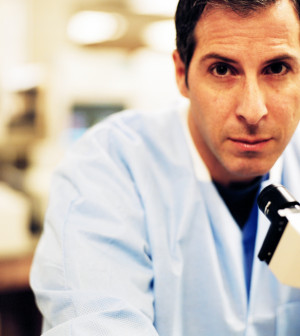- Navigating Your Midlife Crisis: Embracing New Possibilities
- City Raccoons Showing Signs of Domestication
- Mapping the Exposome: Science Broadens Focus to Environmental Disease Triggers
- One Week Less on Social Media Linked to Better Mental Health
- Your Brain Changes in Stages as You Age, Study Finds
- Some Suicide Victims Show No Typical Warning Signs, Study Finds
- ByHeart Formula Faces Lawsuits After Babies Sickened With Botulism
- Switch to Vegan Diet Could Cut Your Greenhouse Gas Emissions in Half
- Regular Bedtime Does Wonders for Blood Pressure
- Dining Alone Could Mean Worse Nutrition for Seniors
C-Sections May Be Causing Evolutionary Changes

Why is it so difficult and painful for human females to give birth? Researchers have developed a new theory: Evolution favored small female pelvises and large newborns for good reasons.
And, the researchers said, the rise of cesarean sections — the surgical delivery of a baby — in recent decades may be contributing to an even bigger gap between the size of newborns and their mothers’ pelvises. In fact, the researchers estimate that the regular use of C-sections has led to a 10 to 20 percent increase in the gap between female pelvis width and babies’ size.
“Evolution is happening even in our modern society,” said study lead author Philipp Mitteroecker, an assistant professor with the Department of Theoretical Biology at the University of Vienna, Austria.
But, the human female pelvis has remained small, despite evolution, the researchers said.
“The dimensions of the infant head and shoulders are very close to and even exceed the dimensions of the mother’s birth canal in humans,” said Wenda Trevathan. She’s a professor emeritus of anthropology at New Mexico State University.
This is much different from other mammals, she said.
“Labor contractions are probably painful for most mammals,” Trevathan said. “But, I think it’s safe to say that the long labor required to birth a human baby is more painful and difficult than the apparently shorter labors of other mammals, including apes.”
One theory suggests that human females need smaller pelvises to walk on two feet, Mitteroecker said.
But he believes that the “empirical evidence for this claim is weak.”
In the new study, Mitteroecker and his colleagues created a mathematical model that they believe shows that evolution favored bigger babies because it helped the species survive.
“Medical data show that larger newborns have higher survival rates and are less affected by several diseases,” he said.
The researchers also looked at cesarean section births.
According to the U.S. National Library of Medicine, cesarean surgeries have been around for hundreds of years, but in earlier times they were typically performed on dead or dying mothers in order to save the baby.
There’s no firm evidence that Julius Caesar was a product of this procedure, even though it may be named after him.
In recent years, cesarean rates have grown around the world even though there’s controversy over how many of them are actually needed. Approximately one in three U.S. births is by cesarean, according to the U.S. National Institute of Child Health and Human Development.
“If women have the idea that bigger babies are healthier, and to a point they are, they may choose surgical delivery to have a bigger baby,” Trevathan said.
“The risks of this form of delivery in the absence of medical necessity are great for both mom and baby, especially when the child’s lifelong immune function is considered,” she said. Previous studies have found that an infant’s immune system might benefit from a vaginal delivery by picking up helpful bacteria from a mother’s birth canal.
The authors of the new study estimate that the growth in cesarean sections over the last 60 years has actually affected evolution by making the gap between pelvic size and newborn size even larger.
Wouldn’t this lead to more difficult non-cesarean births? “That’s what we predicted,” Mitteroecker said.
However, “It is difficult to judge how much the rate of birth complications has really increased,” he said.
What’s next as humans continue to evolve? “That’s not easy to foresee,” Mitteroecker said. “But I don’t think that one day every baby needs to be delivered by C-sections.”
The study appears Dec. 5 in the journal Proceedings of the National Academy of Sciences.
More information
For more about the history of cesarean section, try the U.S. National Library of Medicine.
Source: HealthDay
Copyright © 2025 HealthDay. All rights reserved.










